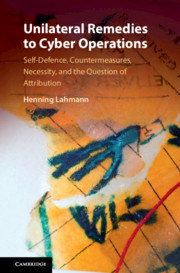 Unilateral Remedies to Cyber Operations
Unilateral Remedies to Cyber Operations from Part II - Unilateral Remedies to Cybersecurity Incidents
Published online by Cambridge University Press: 31 March 2020
A growing number of states have started pointing to the customary doctrine of countermeasures as the most feasible unilateral remedy in the case of a malicious cyber operation carried out by an adversarial actor. Thus, the legal requirements of successfully invoking a right to resort to countermeasures are analysed in depth. In particular, the chapter deals with state policies such as 'active cyber defences' and 'hacking back' as reactions to cybersecurity incidents, and their lawfulness as countermeasures. After examining the pervasive problem of attribution in cyberspace, the states' duty to prevent malicious cyber operations emanating from their territory and the standard of due diligence in this regard are investigated. The chapter concludes with considering the invocation of countermeasures for the purpose of guarantees of non-repetition and reparation in the aftermath of a cybersecurity incident.
To save this book to your Kindle, first ensure no-reply@cambridge.org is added to your Approved Personal Document E-mail List under your Personal Document Settings on the Manage Your Content and Devices page of your Amazon account. Then enter the ‘name’ part of your Kindle email address below. Find out more about saving to your Kindle.
Note you can select to save to either the @free.kindle.com or @kindle.com variations. ‘@free.kindle.com’ emails are free but can only be saved to your device when it is connected to wi-fi. ‘@kindle.com’ emails can be delivered even when you are not connected to wi-fi, but note that service fees apply.
Find out more about the Kindle Personal Document Service.
To save content items to your account, please confirm that you agree to abide by our usage policies. If this is the first time you use this feature, you will be asked to authorise Cambridge Core to connect with your account. Find out more about saving content to Dropbox.
To save content items to your account, please confirm that you agree to abide by our usage policies. If this is the first time you use this feature, you will be asked to authorise Cambridge Core to connect with your account. Find out more about saving content to Google Drive.